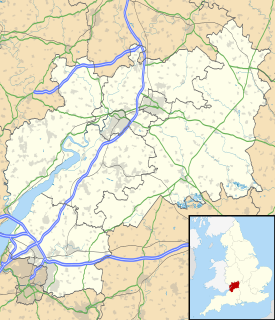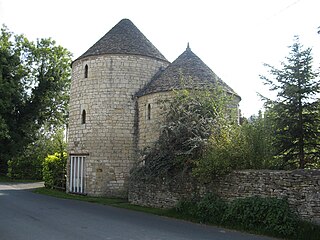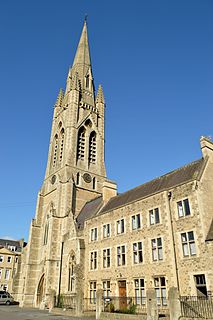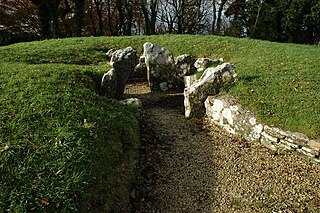
Dursley is a market town and civil parish in southern Gloucestershire, England, situated almost equidistantly between the cities of Bristol and Gloucester. It is under the northeast flank of Stinchcombe Hill, and about 3 3⁄4 miles (6.0 km) southeast of the River Severn. The town is adjacent to Cam which, though a village, is a slightly larger community in its own right.

Stroud is a market town and civil parish in the centre of Gloucestershire, England. It is the main town in Stroud District.

Nailsworth is a town and civil parish in Gloucestershire, England, lying in one of the Stroud Valleys in the Cotswolds, on the A46 road, 3.5 miles (5.6 km) south of Stroud and about 25 miles (40 km) north-east of Bristol and Bath. The parish had a population of 5,794 at the 2011 census.

Woodchester is a Gloucestershire village in the Nailsworth Valley, a valley in the South Cotswolds in England, running southwards from Stroud along the A46 road to Nailsworth. The parish population taken at the 2011 census was 1,206.

Stroud is a constituency represented in the House of Commons of the UK Parliament.

Uley is a village and civil parish in the county of Gloucestershire, England. The parish includes the hamlets of Elcombe and Shadwell. The village is situated in a wooded valley in the Cotswold escarpment, on the B4066 road between Dursley and Stroud. The placename probably signifies 'clearing in a yew wood'.

Coaley is a village in the English county of Gloucestershire roughly 4 miles from the town of Dursley, and 5 miles from the town of Stroud. The village drops from the edge of the Cotswold Hills, overlooked by Frocester Hill and Coaley Peak picnic site, towards the River Cam at Cam and Cambridge and the Severn Estuary beyond. It has a population of around 770.

Arlingham is a village and civil parish in the Stroud District of Gloucestershire, England. The 2001 Census recorded a parish population of 410, increasing to 459 at the 2011 census. The parish contains the hamlets of Milton End, Overton and Priding The next parish to the east is Fretherne with Saul.

Woodchester Mansion is an unfinished, Gothic revival mansion house in Woodchester Park in Woodchester, near Nympsfield, Gloucestershire, England. It is on the site of an earlier house known as Spring Park. The mansion is a Grade I listed building.

Owlpen is a small village and civil parish in the Stroud district of Gloucestershire, England, set in a valley in the Cotswold hills. It is about one mile east of Uley, and three miles east of Dursley. The Owlpen valley is set around the settlement like an amphitheatre of wooded hills open to the west. The landscape falls within the Cotswold Area of Outstanding Natural Beauty, so designated in 1966. The population of the parish in mid-2010 was 29 (est.), the smallest in Gloucestershire.

Coaley Peak is a picnic site and viewpoint in the English county of Gloucestershire.

Rodborough is a civil parish in the district of Stroud, Gloucestershire, in Southwest England. It is directly south of the town of Stroud, north of the town of Nailsworth and north-west of the village of Minchinhampton. The parish includes the settlements of Bagpath, Butterrow, Kingscourt, Lightpill and Rooksmoor, and is adjacent to the Stroud suburb of Dudbridge. The population taken at the 2011 census was 5,334.

St. John the Evangelist Roman Catholic Church is located on the South Parade in the south-east section of Bath City Centre – the old Ham District where John Wood the Elder, the Georgian architect, had originally planned his gigantic "Forum".

Bencombe is a hamlet made up of 9 mainly traditional stone cottages/houses in the parish of Uley and just south west of Owlpen on the edge of the Cotswolds in Gloucestershire, England.

Uley Long Barrow, also known locally as Hetty Pegler's Tump, is a Neolithic burial mound, near the village of Uley, Gloucestershire, England.

Benjamin Bucknall was an English architect of the Gothic Revival in Southwest England and South Wales, and then of neo-Moorish architecture in Algeria. His most noted works include the uncompleted Woodchester Mansion in Gloucestershire, England and his restoration of the Villa Montfeld in El Biar, Algiers.

Nympsfield Long Barrow is the remains of a Neolithic burial site or barrow, located close to the village of Nympsfield in Gloucestershire, South West England.

The hundred of Berkeley was one of the ancient hundreds of Gloucestershire, England. Hundreds originated in the late Saxon period as a subdivision of a county and lasted as administrative divisions until the 19th century.















